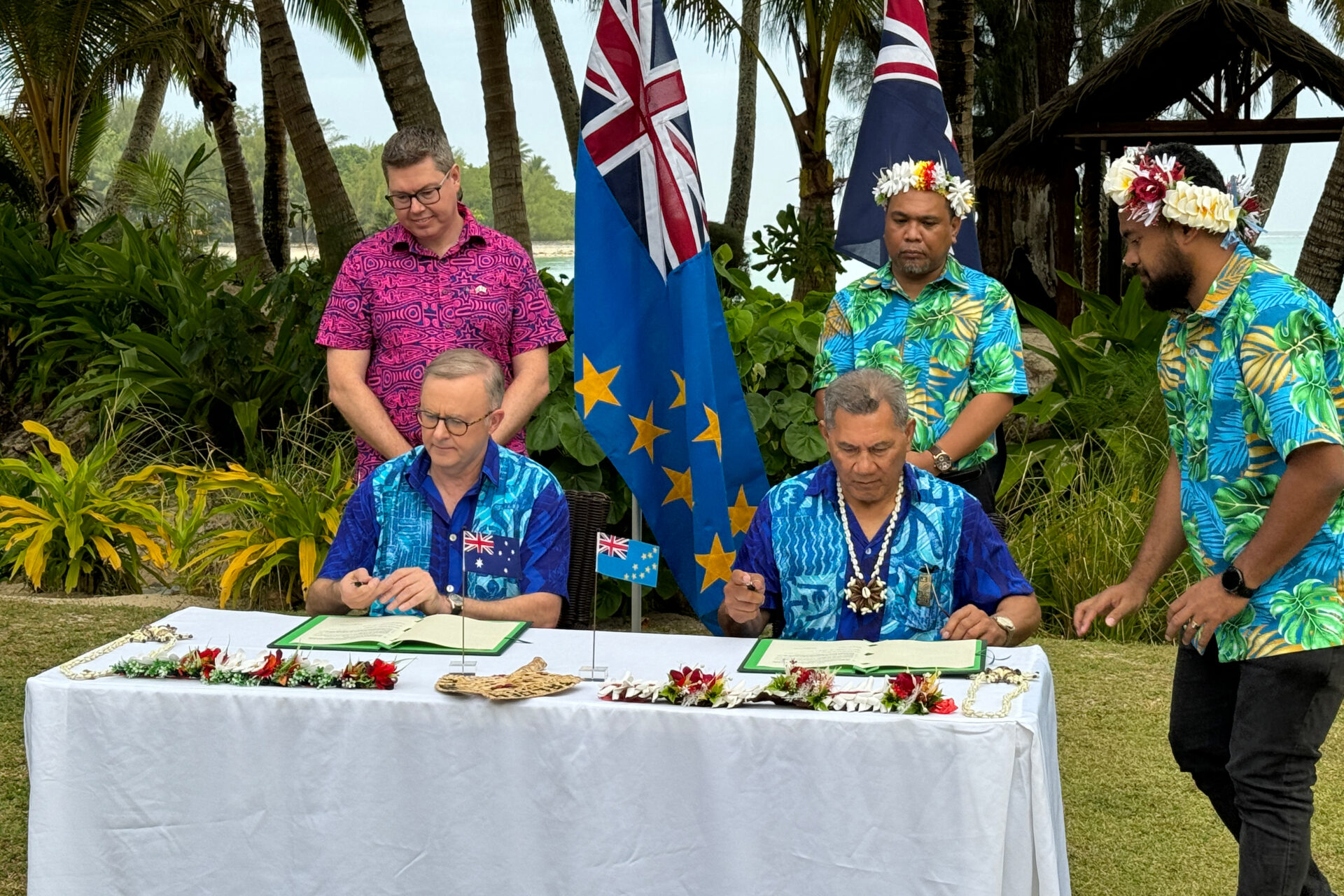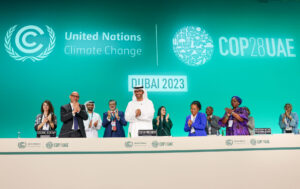How Labor out-loved the Coalition in its embrace of big oil and gas

“You know what you’ve been doing,” said Foreign Minister and Leader of the Government in the Senate, Senator Penny Wong, wagging her finger at the Opposition senators across the Chamber.
“You said ‘no’ to Santos. You then said ‘no’ to Woodside. You’ve said ‘no’ to Inpex.”
A smile spread across her face, seemingly in delight at being able to chastise the Coalition for being less of a friend to the oil and gas industry than the Labor Party.
Those few words, uttered in a few seconds last Friday afternoon, speak volumes about the government’s embrace of fossil fuels, and the flaws in its climate change policy.
Saying the quiet part out loud…🙃
When the opposition wouldn't cooperate with the government attempting to ram through their favour for Santos – the Sea Dumping Bill – this happened:
"You said no to Santos."
"You said no to Woodside. "
"You said no Inpex."#auspol pic.twitter.com/X3Vp0E5OJj— Australia Institute (@TheAusInstitute) November 10, 2023
More subtle than ScoMo bringing a lump of coal into Parliament, for sure, but telling.
More subtle than ScoMo bringing a lump of coal into Parliament, for sure, but telling.
The context for Wong’s comments was a debate about the government’s Environment Protection (Sea Dumping) Amendment (Using New Technologies to Fight Climate Change) Bill.
It’s a title that might have made George Orwell chuckle.
In theory, the bill is about meeting Australia’s obligations under international law to protect the marine environment.
In practice, it’s about enabling a massive expansion of the gas industry.
Historically, importing and exporting carbon dioxide emissions for disposal under the sea has been restricted by a global protocol, and without this legislation, it’s banned in Australia.
The new law would create a regulatory system for carbon dioxide exports, allowing CO2 to be transported into international waters and pumped under the seabed in what are known as carbon capture and storage projects.
Its passage is important for gas companies, particularly Santos.
Without that law, Santos’s $5.8 billion Barossa gas project could not go ahead.
Santos wants to extract gas from one of the dirtiest gas fields in the world, under the Timor Sea in Australian territorial waters, nearly 300 kilometres north of Darwin.
The carbon dioxide content of the gas reservoir is extremely high, and Barossa would be one of the most emissions-intensive gas projects in the world.
The carbon dioxide content of the gas reservoir is extremely high, and Barossa would be one of the most emissions-intensive gas projects in the world.
It can’t comply with the safeguard mechanism unless it offsets or captures CO2, and there’s no way, amid concerns about catastrophic global warming, that Santos could gain investor and financier support for the project absent a claim that it will stop the emissions from reaching the atmosphere.
According to Santos, it will store carbon dioxide under the sea floor in its soon-to-be depleted gas field in the waters of Timor Leste, called Bayu-Undan.
In a hugely expensive and energy-intensive exercise, it plans to pipe Barossa’s gas 300 kilometres to its Darwin LNG plant, and to transport removed and compressed CO2 via Darwin to the Bayu-Undan field 500 kilometres away off Timor Leste.
Given the huge costs involved, there are serious doubts about whether the CCS project will actually happen, and if it does, whether it will work.
The precedents are not good.
Gas giant Chevron’s attempts to bury emissions from its Gorgan gas project in north-west WA have been failing for years, with millions of tonnes of CO2 that were meant to be stored under Barrow Island released into the atmosphere – contributing to global warming.
More than six years on, the company admits the CCS plant is only operating at one third of capacity.
It’s a problem acknowledged worldwide.
As the Senate debated the sea dumping amendment bill, the United Nations Environment Program released its “production gap” report, outlining the chasm between governments’ planned fossil fuel production and the reduction in fossil fuel output needed to limit global warming to 1.5 or 2 degrees Celsius.
It noted the “large uncertainties in the technical, economic, and institutional feasibility” of developing fossil-fuel CCS projects at extensive scale, and observed that 80% of pilot CCS projects over the past 30 years have failed.
“Given risks and uncertainties of CCS … countries should aim for a near total phase-out of coal production and use by 2040 and a combined reduction in oil and gas production and use by three-quarters by 2050 from 2020 levels, at a minimum,” the report said.
“The potential failure of these measures to become sufficiently viable at scale, the non-climatic near-term harms of fossil fuels, and other lines of evidence, call for an even more rapid global phase-out of all fossil fuels.”
Yet Australia seems wedded to the CCS pipedream.
In the Senate last week, the Greens and Senator David Pocock mounted a five-day filibuster that delayed Labor’s legislation.
On five occasions, the government tried to gag debate. On each occasion it failed.
The Coalition was apparently happy to watch on and enjoy the government’s frustration.
That is what prompted Senator Wong’s taunting and chiding of the Opposition for saying “no” to big oil and gas.
But it was inevitable the Coalition would finally back the new laws – the legislation passed the upper house on the evening of November 13 – and in much of the media, the extraordinary filibuster didn’t rate a mention; even less so the substance of the issues at hand.

On the same day that Penny Wong admonished the Coalition over its lack of support for the gas giants, Prime Minister Albanese was in the Cook Islands for the Pacific Islands Forum, where he announced a deal to allow citizens of Tuvalu – whose low-lying islands are threatened by rising sea levels – to resettle in Australia.
The forum communiqué watered down earlier calls by some Pacific leaders for a “fossil fuel free Pacific”, instead merely setting this as a goal to “aspire” to.
To accommodate Australia, no doubt, it also added the caveat “that the pathway is not immediate nor is it one-size fits all”
It isn’t hard to draw a conclusion from this: that the focus is shifting to mitigation of climate disaster, as the Australian petrostate commits to its subsidised fossil fuel expansion.
Between the Lines Newsletter
The biggest stories and the best analysis from the team at the Australia Institute, delivered to your inbox every fortnight.
You might also like
What is the PRRT?
Gas extraction is often lauded by the industry as the ‘backbone of the Australian economy’, but the actual revenue collected from one of the main taxes on the industry falls staggeringly short of what most people would expect. Find out why this is the case – and what we can do to fix it.
The New Face of Climate Denial
Old-fashioned climate change denialism is the risk you run when you hold an international climate conference in a Middle Eastern petrostate and hand the reins to an oil baron, writes Stephen Long, but in practice, is Australia really much better?
The Coalition’s nuclear power crusade is a futile distraction
Nuclear energy really is remarkable.



